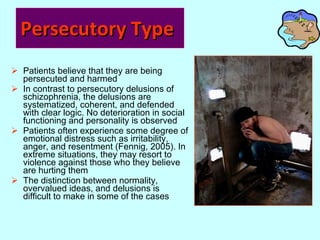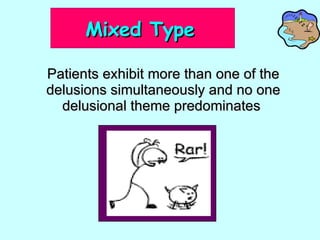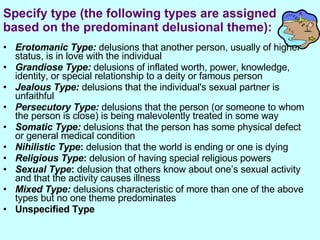- 1. Delusional Disorders NCM 401 Ma. Tosca Cybil A. Torres, RN
- 2. Key terms: Delusions: false beliefs based on incorrect inference about external reality that persist despite the evidence to the contrary and these beliefs are not ordinarily accepted by other members of the person's culture or subculture Bizarre delusions: clearly implausible, not understandable, and not derived from ordinary life experiences Non-bizarre delusions: beliefs of something occurring in a person's life which is not out of the realm of possibility
- 3. characterized by the presence of non-bizarre delusions which have persisted for at least one month People who have this disorder generally don't experience a marked impairment in their daily functioning in a social, occupational or other important setting Outward behavior is not noticeably bizarre or objectively characterized as out-of-the-ordinary Delusional Disorder Defined:
- 4. ETIOLOGICAL THEORIES Psychodynamics Emotional development is delayed because of a lack of maternal stimulation / attention. The infant is deprived of a sense of security and fails to establish basic trust. A fragile ego results in severely impaired self-esteem, a sense of loss of control, fear, and severe anxiety. A suspicious attitude toward others is manifested and may continue throughout life. Projection is the most common mechanism used as a defense against feelings. Biological A relatively strong familial pattern of involvement appears to be associated with these disorders. Individuals whose family members manifest symptoms of these disorders are at greater risk for development than the general population. Twin studies have also suggested genetic involvement. Family Dynamics Some theorists believe that paranoid persons had parents who were distant, rigid, demanding, and perfectionistic, engendering rage, a sense of exaggerated self-importance, and mistrust in the individual. The clients become vulnerable as adults because of this early experience. Neurobiologic Perspective thought to involve an abnormality in the neural impulse transmission of the neurochemicals dopamine, serotonin and norephineprine.
- 5. Behavioral Clinical Findings: exhibits an elaborate, highly organized paranoid delusional system while preserving other functions of the personality Apart from the impact of the delusions, thinking and functioning is not interfered with, nor is it bizarre. Personality function continues Delusions are drawn from real life situations and have a coherent theme. Hallucination is not prominent; if present, usually auditory and are related to delusional theme Predominant theme of delusions determines type of paranoia
- 6. Subtypes of Delusional Disorder
- 7. Related terms include erotomania, psychose passionelle, Clerambault syndrome, and old maid's insanity The central theme of delusions is that another person, usually of higher status, is in love with the patient. The object of delusion is generally perceived to belong to a higher social class, being married, or otherwise unattainable Patients with this type of delusion are generally female, although males predominate in forensic samples Delusional love is usually intense in nature. Signs of denial of love by the object of the delusion are frequently falsely interpreted as affirmation of love Patients may attempt to contact the object of the delusion by making phone calls, sending letters and gifts, making visits, and even stalking. Some cases lead to assaultive behaviors as a result of attempts to pursue the object of delusional love or attempting to "rescue" her/him from some imagined danger Erotomanic Type
- 8. Grandiose Type Patients believe that they possess some great and unrecognized talent, have made some important discovery, have a special relationship with a prominent person, or have special religious insight Grandiose delusions in the absence of mania are relatively uncommon, and the distinction of this subtype of disorder is debatable. Many patients with paranoid type show some degree of grandiosity in their delusions
- 9. Jealous type Related terms include conjugal paranoia, Othello syndrome, and pathological or morbid jealousy The main theme of the delusions is that her or his spouse or lover is unfaithful. Some degree of infidelity may occur; however, patients with delusional jealousy support their accusation with delusional interpretation of "evidence" (eg, disarrayed clothing, spots on the sheets) Patients may attempt to confront their spouses and intervene in imagined infidelity. Jealousy may evoke anger and empower the jealous individual with a sense of righteousness to justify their acts of aggression. This disorder can sometimes lead to acts of violence, including suicide and homicide.
- 10. Persecutory Type Patients believe that they are being persecuted and harmed In contrast to persecutory delusions of schizophrenia, the delusions are systematized, coherent, and defended with clear logic. No deterioration in social functioning and personality is observed Patients often experience some degree of emotional distress such as irritability, anger, and resentment (Fennig, 2005). In extreme situations, they may resort to violence against those who they believe are hurting them The distinction between normality, overvalued ideas, and delusions is difficult to make in some of the cases
- 11. Somatic Type Related terms include monosymptomatic hypochondriasis The core belief of this type of disorder is delusions around bodily functions and sensations. The most common are the belief that one is infested with insects or parasites, the belief of emitting a foul odor, the belief that parts of the body are not functioning, and the belief that their body or parts of the body are misshapen or ugly Patients are totally convinced in physical nature of this disorder, which is contrary to patients with hypochondriasis who may admit that their fear of having a medical illness is groundless Patients are usually first seen by dermatologists, cosmetic surgeons, urologists, gastroenterologists, and other medical specialists Sensory experiences associated with this illness (eg, sensation of parasites crawling under the skin) are viewed as components of systemized delusions
- 12. Nihilistic Type "delusions of nothingness“ The sufferer may believe that they or the world has ceased to exist, that they are dead, or that parts of the body or mind have vanished.
- 13. Mixed Type Patients exhibit more than one of the delusions simultaneously and no one delusional theme predominates
- 14. Unspecified Type Delusional themes fall outside the specific categories or cannot be clearly determined Misidentification syndromes such as Capgras syndrome (characterized by a belief that a familiar person has been replaced by an identical impostor) or Fregoli syndrome (a belief that a familiar person is disguised as someone else) fall into this category. Misidentification syndromes are rare and frequently are associated with other psychiatric conditions (eg, schizophrenia) or organic illnesses (eg, dementia, epilepsy) Another unusual syndrome is Cotard syndrome, in which patients believe that they have lost all their possessions, status, and strength as well as their entire being, including their organs. Described first in the 19th century, it is a rare condition, which is usually considered a precursor to a schizophrenic or depressive episode.
- 15. Specific Diagnostic Criteria for Delusional Disorder Nonbizarre delusions (i.e., involving situations that occur in real life, such as being followed, poisoned, infected, loved at a distance, or deceived by spouse or lover, or having a disease) of at least 1 month's duration. Criterion A for Schizophrenia has never been met. Note: Tactile and olfactory hallucinations may be present in Delusional Disorder if they are related to the delusional theme.
- 16. Criterion A of Schizophrenia requires two (or more) of the following, each present for a significant portion of time during a 1-month period (or less if successfully treated): delusions hallucinations disorganized speech (e.g., frequent derailment or incoherence) grossly disorganized or catatonic behavior negative symptoms, i.e., affective flattening, alogia, or avolition Note: Criteria A of Schizophrenia requires only one symptom if delusions are bizarre or hallucinations consist of a voice keeping up a running commentary on the person's behavior or thoughts, or two or more voices conversing with each other.
- 17. C. Apart from the impact of the delusion(s) or its ramifications, functioning is not markedly impaired and behavior is not obviously odd or bizarre. D. If mood episodes have occurred concurrently with delusions, their total duration has been brief relative to the duration of the delusional periods. E. The disturbance is not due to the direct physiological effects of a substance (e.g., a drug of abuse, a medication) or a general medical condition.
- 18. Specify type (the following types are assigned based on the predominant delusional theme): Erotomanic Type: delusions that another person, usually of higher status, is in love with the individual Grandiose Type: delusions of inflated worth, power, knowledge, identity, or special relationship to a deity or famous person Jealous Type: delusions that the individual's sexual partner is unfaithful Persecutory Type: delusions that the person (or someone to whom the person is close) is being malevolently treated in some way Somatic Type: delusions that the person has some physical defect or general medical condition Nihilistic Type : delusion that the world is ending or one is dying Religious Type : delusion of having special religious powers Sexual Type : delusion that others know about one’s sexual activity and that the activity causes illness Mixed Type: delusions characteristic of more than one of the above types but no one theme predominates Unspecified Type
- 19. Therapeutic Intervention: Psychotherapy the most effective help in person suffering from delusional disorder The overriding important factor in this therapy is the quality of the patient/therapist relationship Trust is a key issue, as is unconditional support If the client believes that the therapist really does think he or she is "crazy," the therapy can terminate abruptly. Early in the therapy, it is vital not to directly challenge the delusion system or beliefs and instead to concentrate on realistic and concrete problems and goals within the person's life.
- 20. Once a firm, supportive therapeutic relationship has been established, the therapist can begin reinforcing positive gains and behaviors the individual makes in his or her life, such as in educational or occupational gains. It is important to reinforce these life events (such as getting a job), because it reinforces in the patient a sense of self-confidence and self-reliance.
- 21. Only when the client has begun to feel more secure in their social or occupational world can more productive work be accomplished in therapy. This involves the gradual but gentle challenging of the client's delusional beliefs, starting with the smallest and least-important items. Occasionally making these types of gentle challenges throughout therapy will give the clinician a greater understanding of how far along the individual has come. If the patient refuses to give up his or her delusion beliefs, even the smallest ones, then therapy is likely to be very long-term. Even if the client is willing, therapy is likely to take a fair amount of time, from at least 6 months to a year.
- 22. Clinicians should always be very direct and honest, especially with people who suffer from delusion disorder. Professionals should be even more careful than usual not to impinge on the client's privacy or confidentiality, and to say plainly what they mean in therapy sessions. Subtlety and sarcasm may be easily misinterpreted by the patient. Therapy approaches which focus on insight or self-knowledge may not be as beneficial as those stressing social skills training and other behaviorally and solution-oriented therapies.
- 23. Application of the Nursing Process: Assessment: History taking from client and family Presence of hallucinations and delusional ideation; may constitute danger to self/others Presence of suspiciousness; paranoid feelings are usually limited to specific areas in the patient’s life Absence of odd/bizarre behavior and other criteria r/t schizoprenia
- 24. Nursing Diagnoses: Anxiety r/t disturbed processes about specific areas, mistrust of others, difficulty in dealing with certain aspects of reality and threats to security Ineffective Individual coping r/t poorly developed/inappropriate use of defense mechanism Risk for loneliness r/t mistrust of others and threats to security Self-esteem disturbance r/t perceptual/cognitive impairment, feelings of grandiosity and/ feelings of persecution Altered thought processes r/t misinterpretation of events Risk for violence: directed at others r/t feelings of suspicion/distrust of others and misinterpretation of stimuli
- 25. Planning/Implementation: Provide an environment with some intellectual challenges that do not threaten security Provide open, honest atmosphere in which client can begin to trust self / others. Accept and recognize the patient’s need for a superior attitude Meet sarcasm and ridicule in a matter-of-fact matter Guard patient’s self-esteem from attack by other patients Accept patient’s misinterpretation of events Point out reality but do not directly challenge the patient’s delusions Encourage client / family to focus on defining methods for coping with anxieties and life stressors. Promote a sense of self-worth and increased self-esteem.
- 26. Evaluation: Copes with anxiety without the use of threats or assaultive behavior. Recognizes reality; agrees to give up or live with the delusional system. Client / family / SOs participate in therapy (e.g., behavioral, group). Family / SO(s) provide emotional support for the client. Plan in place to meet needs after discharge.
- 27. End of Discussion



























